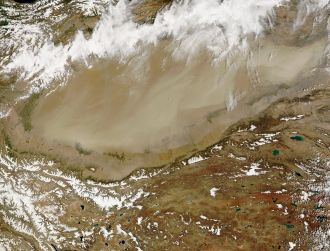Takla Makan Desert
The Taklamakan (also Taklimakan) is a desert of Central Asia, in the Xinjiang Uyghur Autonomous Region of the People's Republic of China. It is known as the largest sand-only desert in the world. Some references fancifully state that Taklamakan means "if you go in, you won't come out"; others state that it means "Desert of Death" or "Place of No Return". "Makan" is a Turkic word meaning "place", of Arabic origin: the word may mean something different if treated as original pre-Islamic native Turkic. A more realistic derivation of the meaning should rather be as follows: "takla" has the meaning of "return" or "revolve" in Turkic; "ma" is a suffix of negation; and finally "kan" is a gerund suffix; altogether we obtain the expression that would be understood in Turkic languages as "unreturnable".
It covers an area of 270,000 km² of the Tarim Basin, extending between roughly 78° to 88° E longitude and 37° to 40° N latitude. It is crossed at its northern and at its southern edge by two branches of the Silk Road. The key oasis towns are Kashgar, Yarkand, and Khotan (Hetian) in the South-West, Kuqa and Turfan in the North, and Loulan and Dunhuang in the East.
The White Jade River flows into the Taklamakan, as do the Yarkant He originating in the Kunlun mountains and the Torkan He from the Tien Shan range.
The archeological treasures found in its sand buried ruins point to Tocharian, early Hellenistic, and Indian/Buddhistic influences. Its treasures and dangers have been vividly described by Aurel Stein, Sven Hedin, Albert von Le Coq, and Paul Pelliot. More recently, Antonio Graceffo crossed the desert and wrote about his experiences.
Numerous mummies, some 4000 years old, have been found in the region. They show the wide range of peoples who have passed through. Many of the mummies appear European and may have been members of the Tocharians, who spoke Tocharian, an Indo-European language.
Later, the Taklamakan was inhabited by Turkic peoples. Starting with the Tang Dynasty, the Chinese periodically extended their control to the oasis cities of the Taklamakan in order to control the important silk route trade across Central Asia. Periods of Chinese rule were interspersed with rule by Turkic and Mongol and Tibetan peoples. The present population consists largely of Turkic Uyghur and Kazakh people in the countryside, while the population of the larger cities is predominantly Han Chinese.
Sources and Further Reading
- Jarring, Gunnar. 1997. The toponym Takla-makan Turkic Languages. Vol. 1.
- Hopkirk, Peter. 1984. Foreign devils on the Silk Road: the search for the lost cities and treasures of Chinese Central Asia. Amherst: University of Massachusetts Press. ISBN 0870234358 and ISBN 9780870234354
- Hopkirk, Peter. 1994. The great game: the struggle for empire in central Asia. Kodansha globe. New York: Kodansha International. ISBN 1568360223 and ISBN 9781568360225
- Graceffo, Antonio. 2005. The desert of death on three wheels. Columbus, Ohio: Gom Press. ISBN 1932966374 and ISBN 9781932966374
See also
- Tarim mummies
- List of deserts by area
External links
- Graceffo, Antonio. Taklamakan Desert. Escape Artist. Retrieved April 28, 2007.
- Satellite Images from China. China Profile. Retrieved April 28, 2007.
- Bezlova, Antoaneta. November 8, 2006. Taklamakan - Desert With No Ocean Underground, Inter Press Service News Agency. Retrieved April 30, 2007.
- Takla Makan Desert, TravelChinaGuide. Retrieved April 30, 2007.
- Wang Binghua. April 1996. The Most Important Findings of Niya in Taklamakan, Silk Road Foundation. Retrieved April 30, 2007.
| Deserts |
|---|
| Ad-Dahna | Alvord | Arabian | Aral Karakum | Atacama | Baja California | Barsuki | Betpak-Dala | Chalbi | Chihuahuan | Dasht-e Kavir | Dasht-e Lut | Dasht-e Margoh | Dasht-e Naomid | Gibson | Gobi | Great Basin | Great Sandy Desert | Great Victoria Desert | Kalahari | Karakum | Kyzylkum | Little Sandy Desert | Mojave | Namib | Nefud | Negev | Nubian | Ordos | Owyhee | Qaidam | Registan | Rub' al Khali | Ryn-Peski | Sahara | Saryesik-Atyrau | Sechura | Simpson | Sonoran | Strzelecki | Syrian | Taklamakan | Tanami | Thar | Tihamah | Ustyurt |
Credits
New World Encyclopedia writers and editors rewrote and completed the Wikipedia article in accordance with New World Encyclopedia standards. This article abides by terms of the Creative Commons CC-by-sa 3.0 License (CC-by-sa), which may be used and disseminated with proper attribution. Credit is due under the terms of this license that can reference both the New World Encyclopedia contributors and the selfless volunteer contributors of the Wikimedia Foundation. To cite this article click here for a list of acceptable citing formats.The history of earlier contributions by wikipedians is accessible to researchers here:
The history of this article since it was imported to New World Encyclopedia:
Note: Some restrictions may apply to use of individual images which are separately licensed.

